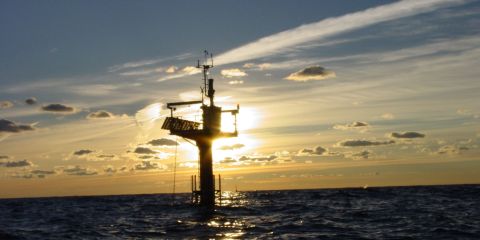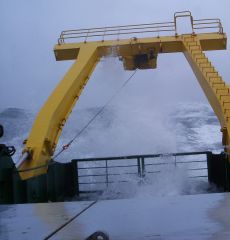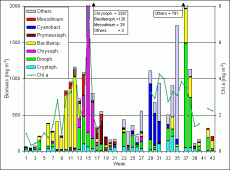

Phytoplankton development at the coastal station "Seebrücke Heiligendamm" in 2006
The results of the weekly sampling at the sea-bridge Heiligendamm (54°08,55' N; 11°50,60' E, 300 m off shore, 3 m water depth), performed by the Baltic Sea Research Institute Warnemünde (IOW) are shown in Fig. 1. The line reflects the chlorophyll a concentration and the columns the phytoplankton wet weight. The phytoplankton biomass was determined by microscopic counting (Utermöhl method) and the chlorophyll a concentration (corrected for phaeopigment) by ethanolic extraction and fluorometric measurement according to the HELCOM manual (http://www.helcom.fi/Monas/CombineManual2/CombineHome.htm).Starting with the sample from 27.9.2006, a new phytoplankton counting program "PhytoWin" was applied. Before, the DOS-version "PHYTO" was used, which was based on an internal IOW list of phytoplankton biovolumes. The PhytoWin is based (since March 2006) on the official HELCOM list (Olenina et al. 2006).
The phytoplankton samples from 31.1.06 (= week 5), 30.5.06 (= week 22), 8.8.06 (= week 32) and 5.9.06 (= week 36) could not be analysed because of high content of resuspended sediments owing to strong wind. No sampling was possible on 11.7.06 (= week 28) because of the visit of US-president George W. Bush in Heiligendamm. No chlorophyll data are available from 9.5. to 30.6.06 as samples were spoiled by impure extraction agent. On 10.10.06 (week 41) and since 30.10.06, the sea bridge Heiligendamm was barred because of reconstruction.
As expected, phytoplankton biomass was low at the beginning of the year. Beside the typical cryptophyceae (Teleaulax sp., Plagioselmis prolonga, Hemiselmis sp.), the autumn dinoflagellate Ceratium tripos and the spring diatom Thalassiosira anguste-lineata were abundant on 17.1.06. By the 7.2.05 (week 6), Actinocyclus sp. developed a biomass of 284 mg m-3. This species declined strongly for the benefit of other diatoms (Porosira glacialis, Rhizosolenia setigera, Thalassiosira nordenskioeldii, Skeletonema "costatum") already one week later. Porosira glacialis continued growing to 236 mg m-3 on 21.2.06 (week 8), while Rhizosolenia setigera, which was dominating in 2005, decreased. Porosira glacialis accounted for the main part of the early stage of the spring bloom, with 413 mg m-3 on 7.3.06 (week 10). Also Skeletonema grew strongly to 191 mg m-3. By use of the common identification books, Skeletonema was traditionally identified as Skeletonema costatum. The taxonomic work by Sarno et al. (2005) showed that also other species have to be taken into consideration. Electron microscopic analyses on the sample from 7.3.06 revealed that the Skeletonema species in the investigated waters should be S. marinoi. This species grew to 415 mg m-3 by 14.3.06. On 21.3.06 (week 12), S. marinoi, Porosira glacialis, Chaetoceros similis und Ch. wighamii formed the bloom to almost equal shares. During the diatom bloom, water temperatures were below 1 °C (except for week 8-9).
The diatom bloom decreased by the 28.3.06 (week 13), while the water temperature increased continuously (to 2.8 °C in week 13, continuing to 7 °C in week 18). From the diatoms, primarily Skeletonema marinoi (107 mg m-3) and Rhizosolenia setigera (50 mg m-3) remained.
Now, Dictyocha speculum and athecate dinoflagellates developed, by the 4.4.06 also Apedinella radians and Mesodinium rubrum. The absolute maximum of the bloom was reached on 11.4.06, established by the naked form of Dictyocha speculum (3350 mg m-3). This species was counted as Chrysophycee in Fig. 1, but forms an own class according to the latest taxonomy.
On 25.4.06 (week 17), the prymnesiophycee Chrysochromulina sp. developed. It nourished heterotrophically (or mixotrophically) as indicated by individuals which had particles on its haptonema. Chrysochromulina sp. decreased with the general phytoplankton biomass decrease in May. The mixotrophic cryptophyceae Plagioselmis prolonga, Teleaulax sp. took benefit from this situation.
At the beginning of June, phytoplankton biomass recovered from the previously registered minimum, especially due to growth of unidentified dinoflagellates. Also prymnesiophytes (probably Chrysochromulina spp.) were frequent on 6.6.06 (week 23); however, due to difficult identification, they were put to "Others" in Fig. 1. On 13.6.06, Leucocryptos marina dominated, but due to its obligatory heterotrophic mode of nutrition it was not included in Fig. 1. The 20.6. (week 25) resembled the 6.6.06. The naked form of Dictyocha speculum, which formed a bloom already in April, showed up again (68 mg m-3) on 4.7.06 (week 27), while Ceratium tripos appeared with 54 mg m-3. A bloom of Anabaena sp. (715 mg m-3) has grown by the 18.7.06 (week 29), and Ceratium tripos has increased to 97 mg m-3. A species shift within the nitrogen-fixing cyanobacteria from Anabaena sp. to Nodularia spumigena (347 mg m-3) and Aphanizomenon sp. (93 mg m-3) occurred in week 30. This bloom, dominated by Nodularia spumigena, persisted at least until 1.8.06 an. The cyanobacteria bloom was especially strong this year, with high local variability. On some occasions in August 2006 (11.8., 17.8.), bathing was forbidden at some places in northwest-Mecklenburg. Strong blooms occurred in front of Warnemünde from 14.-17.8.06 and around the 28.8.06. The intensity was obviously lower in front of Heiligendamm on the sampling days in August.
On 15.8.06 (week 33), Ceratium tripos (162 mg m-3) and Plagioselmis prolonga (137 mg m-3) dominated. A short occurrence of Coscinodiscus granii (159 mg m-3) on 22.8.06 may indicate outflow of Baltic water. The summer peak of phytoplankton biomass was reached on 29.8.06 with 1732 mg m-3. It was strongly dominated by unidentified algae of a size < 5µm (9.5 Mio cells m-3 < 2µm; 4.2 Mio cells m-3 of 2-5 µm size).
The species composition changed again by the 12.9.06 (week 37). Dinoflagellates dominated: Ceratium fusus (992 mg m-3), Ceratium tripos (400 mg m-3). But also diatoms have developed: Coscinodiscus granii (195 mg m-3), Proboscia alata (91 mg m-3), Cerataulina pelagica (65 mg m-3), Chaetoceros curvisetus (21 mg m-3). On 19.9.06 (week 38), Ceratium tripos (518 mg m-3), Cerataulina pelagica (207 mg m-3), Ceratium fusus (87 mg m-3) and Prorocentrum micans (70 mg m-3) were the most important species.
Starting with week 39, a new biomass list was applied, as stated above. We could argue that this change could have caused the strong decline in biomass. But also the abundances, which are not influenced by this methodological change, decreased strongly from 4,6 Mill. l-1 on 19.9.06 to 0,8 Mill. l-1 on 27.9.06. This is also supported by the decline in chlorophyll a concentrations. Ceratium and have disappeared almost completely, and cryptophyceae (Teleaulax spp., Plagioselmis prolonga) became dominant. On 4.10.06 (= week 40), Ceratium tripos (46 mg m-3) and Coscinodiscus granii (33 mg m-3) were the most important species. The shifts in the ratio of Ceratium tripos and Coscinodiscus granii may be caused by the drift of the water bodies. Inflowing water from the Belt Sea supports Ceratium tripos (e.g. 103 mg m-3 on 16.10.06), while outflowing Baltic water transports Coscinodiscus granii to the sampling station (e.g. 110 mg m-3 on 23.10.06).
Literature
Olenina, I., Hajdu, S., Andersson, A.,Edler, L., Wasmund, N., Busch, S., Göbel,
J., Gromisz, S., Huseby, S., Huttunen, M., Jaanus, A., Kokkonen, P., Ledaine,
I., Niemkiewicz, E. (2006): Biovolumes and size-classes of phytoplankton in
the Baltic Sea. Baltic Sea Environment Proceedings No.106, 144pp.
Internet access:
Paper: http://www.helcom.fi/stc/files/Publications/Proceedings/bsep106.pdf
Tabelle: http://www.helcom.fi/stc/files/Publications/Proceedings/bsep106ANNEX1Biovolumes_web.xls
Sarno, D., Kooistra, W.H.C.F., Medlin, L., Percopo, I., Zingone, A., 2005. Diversity
in the genus Skeletonema (Bacillariophyceae). II. An assessment of the taxonomy
of S. costatum-like species with the description of four new species. J. Phycol.
41, 151-176.
IOW, 22.12.2006
Dr. Norbert Wasmund,
Susanne Busch,
Ina-Marie Topp,
Regina Hansen.

State of the Baltic Sea
- Annual Reports on the state of the Baltic Sea Environment
- Cruise Reports
- Data from the autonomous measuring stations
- Development of the suboxic and anoxic regions since 1969
- Baltic Thalweg transect since 2014
- Algal blooms at Heiligendamm since 1998
- "Major Baltic Inflow" December 2014
- "Major Baltic Inflow" January 2003
- Baltic saline barotropic inflows 1887 - 2018
- Further Reading

